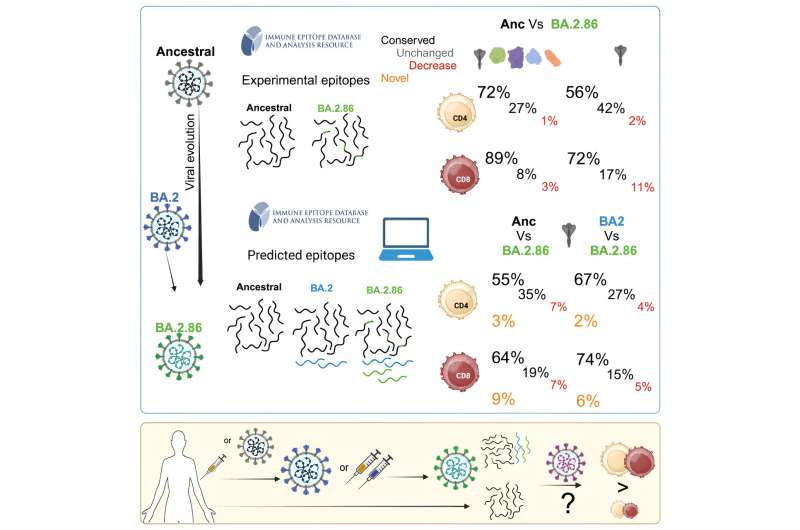This article has been reviewed according to Science X's editorial process and policies. Editors have highlighted the following attributes while ensuring the content's credibility:
fact-checked
peer-reviewed publication
trusted source
proofread
Study shows T cells can tackle new 'Pirola' SARS-CoV-2 variant

In August, researchers detected a new SARS-CoV-2 "variant of concern" in patients in Israel and Denmark. Since then, this variant, dubbed BA.2.86 or "Pirola," has made its way around the globe. The Pirola variant has raised alarms because it is highly mutated. In fact, Pirola is as mutated as the omicron variant was, compared with the early SARS-CoV-2 variant included in the original vaccinations.
As Pirola spreads, researchers at La Jolla Institute for Immunology (LJI) are investigating whether COVID-19 vaccines (or previous SARS-CoV-2 exposure) can still protect people from severe disease.
"There's a concern that a virus with such a high number of mutations would 'escape' T cell immunity," says LJI Professor Alessandro Sette, Dr.Biol.Sci.
Now, a new study in Cell Host & Microbe suggests T cells can see right through Pirola's mutations and find their targets. "Our analysis suggests there is positive news," says LJI Research Assistant Professor Alba Grifoni, Ph.D. "It appears previous exposure to omicron—or vaccination with the newer bivalent vaccines—may arm a person with T cells that can 'catch up' and generate responses specific for fighting Pirola."
Harnessing bioinformatics
For the new study, Sette and Grifoni turned to a resource called the Immune Epitope Database (IEDB). This database houses valuable findings—collected by immunologists around the world—describing how immune cells recognize fragments, or "epitopes," on microbes.
Thanks to the wealth of data in the IEDB, the researchers already had a detailed picture of how COVID-19 vaccines or previous SARS-CoV-2 exposure "trains" T cells to target SARS-COV-2 epitopes. The researchers extracted these IEDB data and developed a bioinformatics pipeline to predict how these T cells would respond to the Pirola variant.
"We simulated the T cell response to Pirola based on experimental and predicted data from previous SARS-CoV-2 variants," says Grifoni.
The researchers found that most T cells could still target epitopes on Pirola:
- Overall, 72 percent of the fragments recognized by CD4+ "helper" T cell responses and 89 percent of CD8+ "killer" T cell epitopes were unchanged, or "conserved," between the variants.
- The researchers found fewer conserved T cell epitopes on Pirola's "Spike" protein, as expected given it harbors most of the mutations. Only 56 percent of CD4+ "helper" T cell epitopes and CD8+ "killer" T cell epitopes were conserved on this major structural protein. That was a potential problem because current COVID-19 vaccines are designed to only teach immune cells to recognize and target Spike epitopes.
- Yet when the researchers took a closer look at the Spike fragments, they found that 96 percent of CD4+ "helper" T cell epitopes and 62 percent of CD8+ "killer" T cell epitopes were similar enough that T cells could probably still recognize them.
In short, if Pirola wants to evade T cells, it isn't doing a very good job.
"A lot of the epitopes recognized by the immune system are still conserved on the new Pirola variant," says Sette. "We strongly predict that the virus will still be recognized by T cells."
"T cells may also be able to 'run' after the Pirola's newly mutated peptides to mount a new response against those epitopes, as we saw for other variants," adds Grifoni. "We think that may play a role in why, despite viral evolution, we haven't seen more severe disease in cases of Pirola infection or other more recent variants."
Next steps
Grifoni emphasizes that these findings are predictions, not observations based on actual Pirola infections. Still, she thinks it is important to see how these "in silico" (in a computer) predictions reflect in recent real-world studies. "We still need experimental validation, but we have established several collaborations worldwide that are investigating this question as we speak," Grifoni says.
Many people are still vulnerable to SARS-COV-2 infection, even the Pirola variant, adds Sette. "That's why people should still be vaccinated, particularly with the updated vaccines."
The researchers are currently collecting experimental data to learn more about T cell responses to variants and further strengthen their prediction tools. Grifoni is especially curious to figure out exactly how people who have had bivalent vaccine boosters and/or "breakthrough" infections mount T-cell responses against future variants.
More information: Alessandro Sette et al, Pre-existing SARS-2 specific T cells are predicted to cross-recognize BA.2.86, Cell Host & Microbe (2023). DOI: 10.1016/j.chom.2023.11.010. www.cell.com/cell-host-microbe … 1931-3128(23)00460-2




















